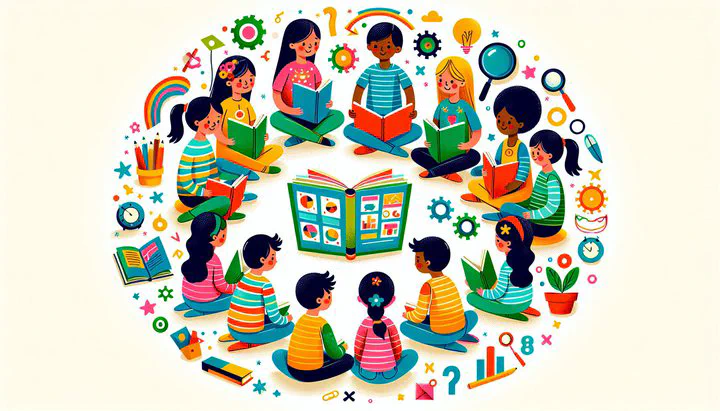Statistics Textbook for Children

Fun and Engaging Statistics Textbooks for Kids
In a world where data is everywhere, understanding statistics is more important than ever. Introducing children to statistics early can give them a head start in developing critical thinking skills. Imagine a child who can make sense of numbers, find patterns, and ask smart questions! This article will guide you through the best ways to teach kids statistics using fun and engaging textbooks.
Why Teach Statistics to Children?
Have you ever wondered how your favorite video game calculates scores or how weather forecasts are made? It’s all about statistics! Teaching statistics to children at an early age helps them develop skills that are valuable in everyday life. By learning to analyze data, kids can make informed decisions and understand the stories behind the numbers.
Statistics is not just about crunching numbers. It’s about understanding and making sense of the world. When kids learn statistics, they learn to think logically and critically. For instance, when deciding how much time to spend on homework versus play, they’re using statistics without even knowing it! This kind of thinking helps them in school and everyday life too.
Understanding basic statistics prepares kids for a data-driven world. Whether they dream of being scientists, economists, or artists, knowing how to work with data is a valuable skill. A statistics textbook for children makes learning fun and engaging, turning complex ideas into simple, understandable concepts. By using real-world examples, these books show kids how statistics apply to things they see and do every day, like sports, cooking, or shopping.
By introducing statistics early, we empower children to ask questions and seek evidence-based answers. With the right resources, like a basic statistics textbook for children, you can make the learning process enjoyable and impactful.
Features of a Good Statistics Textbook for Kids
When choosing a statistics textbook for children, look for these key features to ensure it’s both engaging and educational:
- Age-Appropriate Content: A good textbook breaks down complex ideas into simple, bite-sized pieces. This makes it easier for children to grasp difficult concepts without feeling overwhelmed.
- Engaging Visuals: Bright, colorful pictures, charts, and graphs can capture a child’s attention and make learning more enjoyable. These visuals help illustrate concepts and show how statistics are used in everyday life.
- Interactive Exercises: Activities like puzzles, games, or hands-on projects make statistics come alive. By actively working through problems, children can better understand and remember statistical concepts.
- Online Resources: Some textbooks offer videos, quizzes, or interactive lessons that complement the book’s content. These resources provide extra help and make learning more dynamic and engaging.
By focusing on these features, you can choose a basic statistics textbook for children that supports and inspires young learners.
Top Statistics Textbooks for Children
Finding the right statistics textbook for children can make a big difference in how they learn and enjoy this important subject. Here are some top picks:
-
“The Cartoon Introduction to Statistics” by Grady Klein and Alan Dabney
Perfect for kids who love comics and visual storytelling. It uses cartoons to introduce basic statistics concepts with humor and creativity. Ideal for kids aged 10 and up. -
“Statistics for Kids: Making Sense of Data!” by Kirsten Miller
Simplifies complex ideas using relatable examples and simple language. Best suited for children aged 8 to 12 who are just starting to explore the world of data. -
“Exploring Statistics with Kids” by Michelle A. Hurst
Filled with hands-on projects and experiments, this book emphasizes real-world applications. Recommended for ages 9 to 13, it includes online resources for additional support.
Each book offers a unique approach to teaching statistics to kids, making learning an exciting adventure.
Basic Concepts Covered in Kids’ Statistics Textbooks
A statistics textbook for children usually covers these fundamental concepts in a fun and easy way:
- Mean, Median, and Mode: These are ways to understand data. For example, if a class tracks the number of books each student reads in a month, they can use these concepts to find out what’s typical for the group.
- Probability: This is about the chances of something happening. Kids might think about the likelihood of it raining during recess or picking a red marble from a bag.
- Data Visualization: Involves using charts and graphs to show data clearly. Kids might draw bar graphs to show favorite ice cream flavors or use pie charts for class survey results.
- Collecting and Organizing Data: Kids might conduct simple surveys and learn to organize this information in a table or chart.
These concepts are tools kids can use to understand their world, providing a strong foundation for more complex topics.
Tips for Choosing the Right Statistics Textbook
Here are some tips to help you find the perfect statistics textbook for your child:
- Consider Age and Skill Level: Look for books that match your child’s current knowledge and are neither too easy nor too hard.
- Think About Learning Style: Choose books with colorful graphics if they’re visual learners, or interactive exercises if they prefer hands-on activities.
- Check Content Presentation: Ensure the book uses clear language and simple explanations. Look for relatable examples and real-world scenarios.
- Seek Recommendations: Gather insights from other parents or educators. Online forums like those on StatisticalExplorer can be helpful.
- Involve Your Child: Let them browse different books to see which ones capture their interest.
By following these tips, you can find a statistics textbook for children that not only educates but also excites.
Conclusion
Choosing the right statistics textbook for children is an important step in sparking their interest in data and numbers. With the right book, you can help your child build a solid foundation in statistics and inspire a lifelong curiosity. Encourage them to explore, ask questions, and share their experiences on forums like the StatisticalExplorer community subreddits. Together, let’s make learning statistics a fun and rewarding journey!